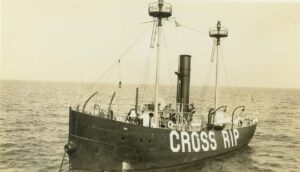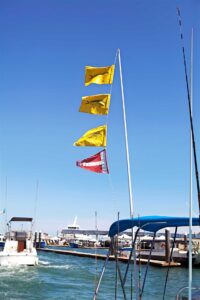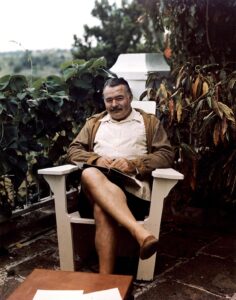The story of Henry Hudson exploring the Hudson River begins in the first decade of the 17th century, the Dutch and English vied to be the dominant world powers. Both countries used their seafaring tradition for trade and colonization, which during that era was the key to national prosperity. However, both of those nations were latecomers to the European colonization scheme.
In 1494, Portugal and Spain had convinced Pope Alexander VI to divide the colonization of the world between those two Iberian Peninsula countries. The Spanish Main, with its gold and silver deposits, included the Caribbean Sea from Puerto Rico to Mexico and Central America. Portugal controlled the African slave trade and spices from the Far East. France was making inroads in North America using their Jesuit missionaries and voyageurs to lay claim to New France, an area that encompassed today’s Canada, the Great Lakes and the Mississippi River valley all the way to the Gulf of Mexico.
What was left to conquer by sea was the dream of locating a Northwest Passage to the Far East. By sailing across the upper reaches of North America to speed ships back and forth to Europe faster than the other available trade routes of the day, lucrative profits would be made for investors in the China trade. All that was required was finding a seafarer and explorer with the ability to find it. Henry Hudson, a 40-something English ship’s captain, was destined to spend the final four years of his life searching for that Northwest Passage, first under British employment and then for the Dutch. In the process, he laid the foundation for the city of New York at the mouth of what is now called the Hudson River.
The Dutch East India Company, founded in 1602, was the first publicly traded business in the world. The company was given a 21-year monopoly for the Dutch spice trade in India and Southeast Asia. Wanting to take full advantage of its monopoly, the Dutch East India Company chose Henry Hudson in 1609 to discover the Northwest Passage. Setting sail from Amsterdam on his ship Half Moon, a three-masted carrack, he reached Cape Cod on August 4, 1602. From there, Hudson sailed south to Chesapeake Bay, then back north to Delaware Bay. Continuing north he reached an estuary on September 3 that was previously discovered in 1524 by the Italian explorer Giovanni da Verrazzano. That estuary, now known as New York Bay, was thought to be a lake by the Italian navigator. Hudson sailed farther into the bay than Verrazzano and found a river, which was first called Mauritius, then the North River and now the Hudson.
Henry Hudson took 10 days to sail up the river to the location of present day Albany, and along the shoreline he traded with some Native American tribes. By September 23, he had sailed down the river and departed back to Europe. That three-week exploration by Hudson was used as the basis for the Dutch claim to the river valley, to a monopoly for trading fur there and the immense wealth it would bring.
Henry Hudson returned one more time in search of the Northwest Passage, on a voyage from 1610 to 1611, during which time he named it Hudson Bay. He wanted to carry on to find the fabled passage, but his crew differed and mutinied instead. Hudson was set adrift in an open boat on the bay, along with his teenage son and a handful of loyal crewmembers. They were never seen or heard from again.
The Dutch had begun annual fur trading voyages up the Hudson River while the mutiny was unfolding. In 1614, the province of New Netherland was established and Fort Orange at Albany was constructed as a trading post. During this time, the French expanded their colonial holdings to the north and west of New Netherland, and the English had a foothold in the region with the Plymouth Colony to the northeast. To protect the Hudson River fur trade operations and the valuable furs stored at the Fort Orange trading post, New Amsterdam was founded in 1625. This fortified outpost was strategically located at the southern tip of Manhattan Island. New Amsterdam soon became the seat of the colonial government of New Netherland.
The following 40 years began an intense commercial rivalry between the Dutch Republic and England. The English sought to end the domination over the seas and world trade held by the Dutch. In 1664, the English invaded and conquered New Amsterdam. The town was renamed New York, in honor of the Duke of York. The following year, armed confrontation continued with the Second Anglo-Dutch War. After peace was declared in 1667, a treaty ending the war formally recognized the English possession of New Netherland and New Amsterdam, and these became the colony of New York and the city of New York, respectively.
Henry Hudson explored the North River up to Albany. This river is a tidal estuary from New York Upper Bay to seven nautical miles past Albany at Troy. It is this location where the tidal influence ends and the Mohawk River enters the Hudson River that the Erie Canal begins its journey west to Buffalo. Cruising the river from New York City to the locks of the Erie Canal offers a glimpse of the history of the founding and growth of the Empire State.
PLANNING TO CRUISE UP THE HUDSON RIVER?
The Hudson River Valley National Heritage Area stretches 115 nautical miles along the river from just north of Manhattan to just north of Troy, N.Y.
WHERE TO DOCK
Jersey City, N.J.
(201-985-8000)
Take a water taxi across the river to New York City to explore Lower Manhattan and take tours of the Statue of Liberty and the Ellis Island Immigration Museum.
Piermont, N.Y.
(845-359-5522)
On the west side of the Tappan Zee Bridge is the village of Piermont, which has done a wonderful job preserving its architecture and history. Visit the historical train station and museum.
Tarrytown, N.Y.
(914-631-1300)
The Tarrytown area is the setting for the Legend of Sleepy Hollow and the Headless Horseman. Just north of Tarrytown, in Ossining, is the infamous Sing Sing prison; a prison museum is scheduled to open in 2019.
Newburgh, N.Y.
(845-661-4914)
Heading upriver to Newburgh is one of the most beautiful stretches along the Hudson, the bend at West Point; today, the home of the U.S. Military Academy.
Shadows Marina on the Hudson River
Poughkeepsie, N.Y.
(845-486-9500)
A short distance north of Poughkeepsie is the historic home of President Franklin Delano Roosevelt at Hyde Park along the eastern bank of the river. The nearby Old Rhinebeck Aerodrome is a living museum featuring air shows with vintage World War I biplanes and triplanes.
Troy, N.Y.
(518-272-5341)
Tour the Flight of Locks at nearby Waterford. It was built in 1907, as part of the Erie Canal, to raise watercraft 165 feet in just over a mile. This is the greatest lift in the shortest distance on any canal system in the world.
Capt. Jeff Werner has been in the yachting industry for over 25 years. In addition to working as a captain on private and charter yachts, both sail and power, he is a certified instructor for the USCG, US Sailing, RYA and the MCA. He is also the Diesel Doctor, helping to keep your yacht’s fuel in optimal condition for peak performance. For more information, call 239-246-6810, or visit MyDieselDoctor.com. All Marinalife members receive a 10% discount on purchases of equipment, products and supplies from Diesel Doctor.




